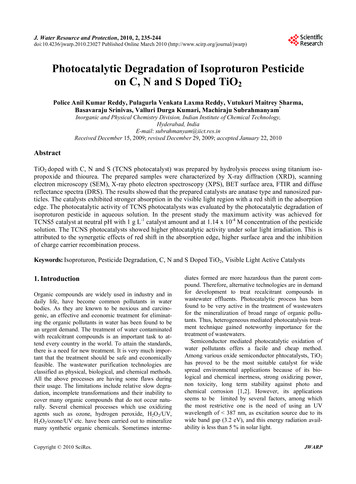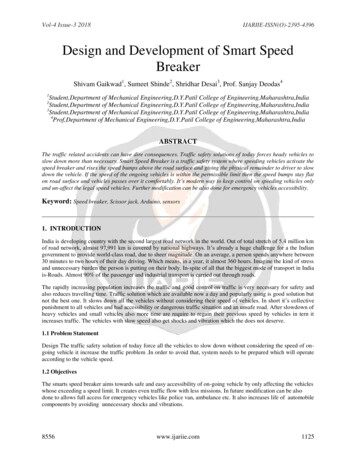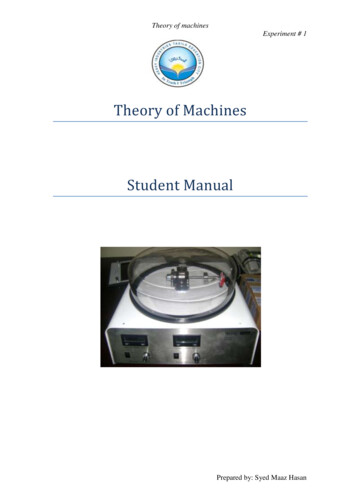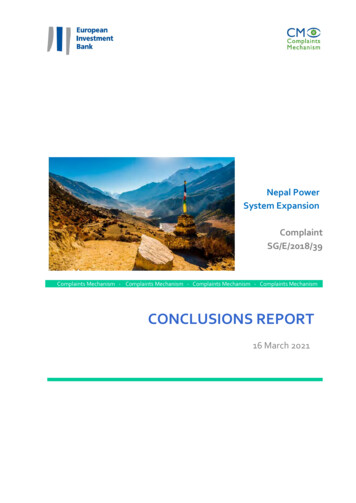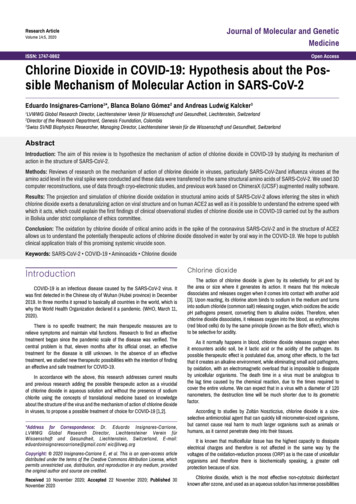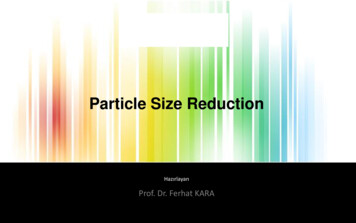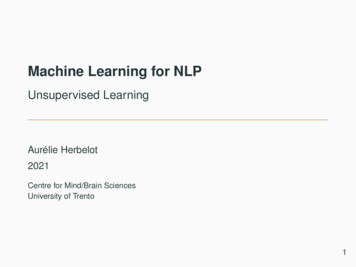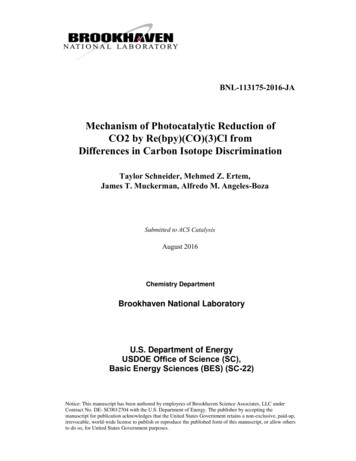
Transcription
BNL-113175-2016-JAMechanism of Photocatalytic Reduction ofCO2 by Re(bpy)(CO)(3)Cl fromDifferences in Carbon Isotope DiscriminationTaylor Schneider, Mehmed Z. Ertem,James T. Muckerman, Alfredo M. Angeles-BozaSubmitted to ACS CatalysisAugust 2016Chemistry DepartmentBrookhaven National LaboratoryU.S. Department of EnergyUSDOE Office of Science (SC),Basic Energy Sciences (BES) (SC-22)Notice: This manuscript has been authored by employees of Brookhaven Science Associates, LLC underContract No. DE- SC0012704 with the U.S. Department of Energy. The publisher by accepting themanuscript for publication acknowledges that the United States Government retains a non-exclusive, paid-up,irrevocable, world-wide license to publish or reproduce the published form of this manuscript, or allow othersto do so, for United States Government purposes.
DISCLAIMERThis report was prepared as an account of work sponsored by an agency of theUnited States Government. Neither the United States Government nor anyagency thereof, nor any of their employees, nor any of their contractors,subcontractors, or their employees, makes any warranty, express or implied, orassumes any legal liability or responsibility for the accuracy, completeness, or anythird party’s use or the results of such use of any information, apparatus, product,or process disclosed, or represents that its use would not infringe privately ownedrights. Reference herein to any specific commercial product, process, or serviceby trade name, trademark, manufacturer, or otherwise, does not necessarilyconstitute or imply its endorsement, recommendation, or favoring by the UnitedStates Government or any agency thereof or its contractors or subcontractors.The views and opinions of authors expressed herein do not necessarily state orreflect those of the United States Government or any agency thereof.
Mechanism of Photocatalytic Reduction of CO2 byRe(bpy)(CO)3Cl from Differences in Carbon IsotopeDiscriminationTaylor Schneider,† Mehmed Z. Ertem, ‡,* James T. Muckerman, ‡ Alfredo M. Angeles-Boza†,*†Department of Chemistry, University of Connecticut, Storrs, Connecticut 06269-3060‡Chemistry Division, Energy & Photon Sciences Directorate, Brookhaven National Laboratory,Bldg. 555A, Upton, New York 11973KEYWORDS: CO2 reduction, photocatalysis, homogeneous catalysis, isotope effects, isotopicdiscrimination.1
ABSTRACT: The rhenium complex Re(bpy)(CO)3Cl (1, bpy 2,2'-bipyridine) catalyzes CO2reduction to CO in mixtures containing triethanolamine (TEOA) as a sacrificial reductant. Themechanism of this reaction under photocatalytic conditions remains to be fully characterized.Here, we report the competitive carbon kinetic isotope effects (13C KIEs) on photocatalytic CO2reduction by 1 and analyze the results of experimental measurements by comparing withcomputed KIEs via density functional theory (DFT) calculations as a means of formulating achemical mechanism and illustrating the utility of this approach. The 13C-KIEs, k(12C)/k(13C), inacetonitrile (ACN) and dimethylformamide (DMF) were determined to be 1.0718 0.0036 and1.0685 0.0075, respectively. When [Ru(bpy)3]Cl2 is added to the reaction mixture inacetonitrile as a photosensitizer, the reduction of CO2 exhibited a 13C-KIE 1.0703 0.0043.These values are consistent with the calculated isotope effect of CO2 binding to the one-electronreduced [ReI(bpy )(CO)3] species. The findings reported here provide strong evidence that the reactions in the two different solvents have the same first irreversible step and proceed withsimilar reactive intermediates upon reduction. Theoretically, we found that the majorcontribution for the large 13C isotope effects comes from a dominant zero-point energy (ZPE)term. These results lay the groundwork for combined experimental and theoretical approachesfor analysis of competitive isotope effects towards understanding CO2 reduction catalyzed byother complexes.2
INTRODUCTIONCatalytic reactions of carbon dioxide reduction have attracted much attention as animportant component of artificial photosynthesis and because of concerns over increasingconcentrations of this greenhouse gas in the atmosphere.1 A variety of systems, bothhomogenous and heterogeneous, have been shown to be active catalysts for CO2 reduction.2-18Despite the advances made in this field, the origins of the catalytic rate enhancement achieved bymany of these systems remain to be fully understood.19-23 This is particularly true when it comesto mechanistic details of the bond forming and bond breaking steps accompanying the reductionof CO2.Among the catalysts for CO2 reduction, Re(bpy)(CO)3Cl (1, bpy 2,2'-bipyridine) and itsderivatives have been recognized as being very active and selective for reduction of CO2 toCO.24-29 Photocatalytic reduction of CO2 to CO in the presence of sacrificial electron donors hasbeen reported for 1. The mechanism of the photochemical CO2 reduction has been studied by anumber of techniques including UV-visible absorption spectroscopy, infrared spectroscopy,electron spin resonance and mass spectrometry.19,27,30-37 On the basis of these studies, plausiblemechanisms have been proposed.20,38 The key equations involved in the proposed mechanismsare shown in Eqs 1-6. Upon photoexcitation, the triplet metal-to-ligand charge transfer (3MLCT)state of 1 is produced. In the presence of a sacrificial electron donor such as TEOA, the 3MLCTexcited state is reductively quenched.35 Upon reduction, the Re complex eliminates the chlorideion, which results in an available coordinating site. CO2 is known to bind to singly reducedrhenium species, for example, the 17-electron species [Re0(bpy)(CO)3] or [ReI(bpy )(CO)3] (eq 3
2).24 Alternatively, the 18-electron species [Re I(bpy)(CO)3] is also a plausible nucleophile,24 although deemed to be less likely when TEOA is used as the sacrificial electron donor. Afterbinding, CO2 is reduced to CO and H2O with multiple protonation steps.In addition, a binuclear pathway involving a rhenium dimer carboxylate intermediate isalso proposed based on the work by Fujita and co-workers in which a one-electron-reducedspecies of a derivative of 1, Re0(dmb)(CO)3 (dmb 4,4'-dimethyl-2,2'-bipyridine), is preparedby photocleavage of the Re-Re bond of [Re(dmb)(CO)3]2.37,39 Furthermore, rhenium-carbonate(A) and -iminoester (B) species have been reported to form during the photochemical reductionof CO2 by 1 (Figure 1).19 The former forms via the insertion of CO2 into the TEOA adduct,[Re(bpy)(CO)3(TEOA)] , when the solvent is DMF, whereas the latter is the product of theattack of TEOA on the acetonitrile (ACN) ligand in [ReI(bpy)(CO)3(ACN)] when the reaction isperformed in ACN .19 The former species has recently been proposed as the active form of the4
catalyst in the photoreduction of CO2 in the presence of TEOA in DMF. However, the chemicaldetails of this conversion have yet to be clarified.Figure 1. Schematic representation of the carbonate (A) and iminoester (B) species formedduring the photochemical reduction of CO2 in DMF and ACN, respectively.Competitive kinetic isotope effects (KIEs) at natural abundance levels have provideddirect information about the nature of the transition state in enzymatic and nonenzymaticreactions.40,41 KIEs arise from changes in the bond orders of the substrate between the groundstate and the transition state. For example, determination of oxygen isotope discrimination wasused to identify the mechanisms of O-O bond formation of water oxidation reactions catalyzedby iron and ruthenium complexes.42-44 These studies indicate that competitive KIEs incombination with density functional theory (DFT) calculations can discern between distinct O-Oformation pathways such as water nucleophilic attack and the interaction of two oxo moieties.More recently, 18O KIEs and computational studies were employed to determine that the firstirreversible and rate-determining step in the catalytic O2 evolution cycle of an oxomanganesecomplex is substrate binding to the catalyst, not the formation of the Mn-oxo/oxyl species aspreviously assumed.45 These reports highlight the power of the methodology to study complexinorganic reaction mechanisms containing multiple isotopically sensitive steps.42,46,475
In the present work, we combine high precision natural abundance competitive 13C KIEsmeasurements with computed isotope effects via density functional theory (DFT) calculations toexamine the mechanism of photochemical CO2 reduction by 1. We further analyze the 13C KIEsusing an established competitive methodology to shed light on the mechanistic details such as theirreversible and rate determining steps associated with photochemical conversion of CO2 to COby 1.RESULTSExperimental Kinetic Isotope Effects. The 13C KIEs for carbon dioxide reduction weremeasured using an established competitive methodology.48 The apparatus design andmethodology is described in detail in the experimental section. The required equipment can beeasily constructed by a professional glassblower. Solutions of TEOA in acetonitrile (ACN) ordimethylformamide (DMF) were saturated with 3% CO2 in N2 prior to initiating reactions byadding a fixed volume of the saturated solution to an evacuated flask containing the catalyst. Thereaction mixtures were stirred and photoirradiated before collecting the unreacted CO2. A seriesof cold traps were used to remove impurities (e.g., solvent, CO) prior to the collection of pureCO2. Pressures of the unreacted CO2 were determined using a calibrated manometer to determinethe extent of the reaction. As previously reported by Hawecker et al., no background reaction ofCO2 was detected in the absence of the catalyst. The change in the 13C/12C and 18O/16O ratios ofunreacted starting material at varying fractional conversions was analyzed by isotope ratio massspectrometry (IRMS) analysis (Figure 2). The degree of fractionation was also determined usingthe photosensitizer [Ru(bpy)3]Cl2. [Ru(bpy)3]2 is an outer sphere electron transfer reagent with abimolecular self-exchange rate constant approaching the diffusion limit.49 Equimolar mixtures of[Ru(dmb)3]2 (dmb 4,4'-dimethyl-2,2'-bipyridine) and Re(dmb)(CO)3Cl have larger turnover6
numbers (100 after 16 h irradiation) than the catalyst alone (15 under the same conditions) forCO formation.50 The reason for this acceleration is attributed to the accumulation of additionalreducing equivalents that increase the rate of the second electron transfer.32 When [Ru(bpy)3]Cl2was used, the experimental procedure described above was varied by introducing the solutions ofTEOA in either ACN or DMF saturated with 3% CO2 in N2 into a sealed reaction vesselcontaining both the catalyst and photosensitizer.Competitive KIEs were determined fitting the data to the Rayleigh equation (eq 7)𝑅! 1 𝑓𝑅!!!!!"#(7)where Rf and R0 are the isotopic ratios (12C/13C) in the remaining CO2 and initial CO2,respectively, and f is the fraction of unreacted CO2.51 The error bars shown in Fig. 2 correspondto the uncertainty associated with the measurement of carbon dioxide samples during calibrationof the apparatus. The 13C KIEs, k(12C)/k(13C), for the photochemical reduction of CO2 catalyzedby 1 were determined to be 1.0718 0.0036 and 1.0685 0.0075 in ACN and DMF,respectively. In the presence of [Ru(bpy)3]Cl2, the photochemical reduction of CO2 exhibited a13C KIE 1.0703 0.0043 (Figure 2).Figure 2. Isotope fractionation of photochemical CO2 reduction catalyzed by complex 1. Plotof the theoretical curve of Rf / R0 vs (1 - f) according to eq 7. All of the data points are shown7with error bars representing standard errors.
The experiments were also expected to determine the 18O KIEs; however, the oxygenatoms are exchanged under the reaction conditions, not allowing accurate determination ofisotope fractionations. When the isotopic composition of samples of CO2 incubated with catalystand TEOA in ACN without exposure to light were measured, the δ13C ranged from 15 ‰ to 14.2 ‰, whereas the δ18O varied from 22.6 ‰ to 14.6 ‰. This result indicated exchange ofthe oxygen atoms, large enough to affect the measurements. Less exchange was observed inDMF but it was still too large to obtain reliable 18O KIE measurements. The exchange of oxygenatoms might be due to the presence of H2O in the solvent.Theoretical Investigation of the CO2 Reduction Mechanism of 1. Density functionaltheory (DFT) calculations at the M06 level of theory coupled with the SMD continuum solvationmethod (see computational methods for details) were used to examine the reaction mechanism ofCO2 reduction by 1 and to compute the 13C KIEs associated with the optimized transition statestructures. The computed free-energy changes for the proposed CO2 reduction mechanism inACN are summarized in Scheme 1 and the results for DMF as the solvent are presented inScheme S2. The results for the initial activation and reduction steps of the catalyst with s(e.g.,[ReI(bpy)(CO)3(ACN)] or[ReI(bpy)(CO)3(DMF)] ) as ligands are reported in the SI and are similar to those previouslyreported in the literature (Scheme S1). Hence, the initial species in Scheme 1 is the one-electronreduced, 17-electron [Re0(bpy)(CO)3] complex generated via reductive quenching of the excited3MLCT state of 1 by TEOA. The first step of the proposed mechanism involves binding of CO2to [Re0(bpy)(CO)3], which proceeds with a free energy of activation (ΔG‡) of 24.6 kcal/mol. Thisvalue is higher than the computed activation free energy for the binding of CO2 to the twoelectron-reduced species [Re I(bpy)(CO)3] (ΔG‡ 16.1 kcal/mol). This is not unexpected given 8
the fact that the two-electron-reduced species is a better nucleophile.24 Indeed, both calculatedΔG‡ values agree well with the activation free-energy barriers estimated from reported pseudofirst-order rate constants for [Re I(bpy)(CO)3] and the [Re0(bpy)(CO)3] species reacting with CO2. Within the adiabatic limit, the ΔG‡ for the reaction of [Re0(bpy)(CO)3S] (S tetrahydrofuran) with CO2 is ca. 22 kcal/mol, whereas that of [Re I(bpy)(CO)3] is 15 kcal/mol.37,52 After the reaction of the [Re0(bpy)(CO)3] with CO2, a second reduction could occurto produce the anionic intermediate [ReI(CO2)(bpy)(CO)3] with a computed reduction potential of E 1.26 V vs SCE (Scheme 1). This reduction step is predicted to be facile given therelatively low free-energy requirement compared to initial reduction events (Scheme S1). Themetallocarboxylate intermediate, [ReI(CO2)(bpy)(CO)3] , can then undergo protonation in a barrierless, highly exoergic (ΔG 23.9 kcal/mol with TEOAH as the proton source) step togenerate [ReI(CO2H)(bpy)(CO)3]. The following steps involve C OH bond breakage to form COby either protonation–reduction or reduction–protonation steps (Scheme 1).22 The protonation–reduction pathway starts with the breakage of the C OH bond in [ReI(CO2H)(bpy)(CO)3] withTEOAH as the proton source (see computational methods for details) and the optimizedtransition state structure features a ΔG‡ of 18.2 kcal/mol. The protonation step is downhill withΔG 8.3 kcal/mol, partly due to entropic gain by release of an H2O molecule, and is followedby a reduction step with an associated potential of E 1.52 V to generate [Re0(bpy)(CO)4]. Onthe other hand, the initial step of the reduction–protonation pathway is the reduction of[ReI(CO2H)(bpy)(CO)3] to [Re0(CO2H)(bpy)(CO)3] with E 1.88 V, followed by concerted protonation and C OH bond breakage with ΔG‡ 11.3 kcal/mol. The evolution of CO from thefinal product of both pathways, [Re0(bpy)(CO)4], completes the catalytic cycle and regenerates9
[Re0(bpy)(CO)3] or [Re I(bpy)(CO)3] with further reduction. The reduction first pathway has been proposed as the preferred route in electrocatalytic reduction of CO2 by 122 but given therelatively low activation free energies for protonation in the presence of TEOAH , it is hard toconclude which path will be preferred in photochemical CO2 reduction by 1. However, as will be13discussed in the next sections, the contribution to competitiveC KIEs is computed to besimilar for both pathways.NNCORe 0OCNCOCOOTS-IONN 16.1ΔG 11.0 CO 2 24.6ΔG 24.0 CO 2COCOΔG‡ΔG‡Re 0NRe -IOCONe COCOCONE 1.83 VCCOE 1.26 VReIICOCOCOTS-IICOReINCORe -INCNe OCONOOOCCOCO TEOAH ,e TEOAH TEOA TEOA ΔG 23.9E 0.22 VONTEAOH ONNCCOReICOCOOHCOReINOHCCOCOΔG‡ 18.2ΔG 8.3 TEOAH e H 2O, TEOAE 1.88 VTS-IIINNO COCONReICONCOCOHCO TEOAH H 2O, TEOAe E 1.52 VΔG‡ 11.3ΔG 16.4CONNCORe 0COCOCORe 0COTEAOH ONNOHCCORe 0COCOTS-IV10
Scheme 1. Reaction mechanism of CO2 reduction by the precatalyst 1 in ACN obtained at theM06 level of theory. The free-energy changes (ΔG) and activation free energies (ΔG‡) arereported in units of kcal/mol and reduction potentials (E) in units of volts vs SCE.Equilibrium isotope effects (EIEs) and KIEs were calculated for each reaction step fromthe computed vibrational frequencies of the optimized structures using the Bigeleisen andGoeppert-Mayer approach, in accord with the Redlich-Teller Product Rule, using the genericisotope equation A B* A* B, where the asterisk designates the site of the heavy isotope,as follows:53,54KIE (13νRC) (ZPE EXC VP)(8)EIE ZPE EXC MMI(9) 3 N 6 exp(hv B * /(2kT )) j j exp(hv B /(2kT )) j ZPE A* 3 N 6 exp(hv /(2kT )) i i exp(hviA /(2kT )) (10) 3 N 61 exp{ (hv Bj* /(kT ))} B j 1 exp{ (hv j /(kT ))} EXC 3 N 6 1 exp{ (hviA* /(kT ))} A i 1 exp{ (hvi /(kT ))} 3 N 6MMI (vBj/ v Bj* )j3 N 6 (v(11)(12)AiA*i/v )i3N 7 (v Bj / v Bj* )jVP 3 N 6 (viA / viA* )i11
(13)where 13νRC is the ratio of the imaginary frequencies of the transition states associated with light,12C, and heavy,13C, isotopologues, ZPE is zero point energy, EXC is vibrational excitationenergy, MMI is mass of moments of inertia and VP is vibrational product. Other terms inequations 10 and 11 include Boltzmann’s constant (k), Planck’s constant (h), and temperature(T). The 13C KIEs were computed for both the CO2 binding and C OH bond cleavage steps, theresults of which are presented in Table 1. The computed intrinsic 13C KIEs for CO2 binding by[Re I (bpy)(CO)3] and [Re0(bpy)(CO)3] are 1.086 and 1.061, respectively, in ACN, and 1.088 and 1.065 in DMF (Table S1). These values are consistent with KIEs reported for binding of smallmolecules to transition metals as well as 13C KIEs measurements for 1 of 1.072 and 1.068 inACN and DMF, respectively. The C OH cleavage steps in either [ReI(CO2H)(bpy)(CO)3] or[Re0(CO2H)(bpy)(CO)3] result in smaller intrinsic 13C KIEs of 1.048 (Table 1 and Table S1). The13C KIE measurements indicate that the first irreversible step determining the isotopefractionation is the same for photochemical conversion of CO2 to CO by 1 in ACN and DMF.Based on computed 13C KIEs, this step is assigned to the binding of CO2 to the one-electronreduced [Re0(bpy)(CO)3] species. CO2 binding to the further reduced [Re I(bpy)(CO)3] species is less likely to be the first irreversible step for two reasons: (i) the computed 13C KIEs are quitehigh compared to the measured KIEs, and (ii) the generation of [Re I(bpy)(CO)3] is not very likely in photocatalytic CO2 reduction by 1 in the presence of TEOA as the sacrificial electrondonor.12
Table 1. Computed 13C KIEs and their contributions at the M06 level of theory in ACN13TSC KIE13νRCZPEMMI EXC[(bpy)Re0 CO2](TS-I)1.0611.011 1.053 1.020 0.978[(bpy)Re I CO2](TS-II)1.0861.033 1.071 0.995 0.986[ReIC(O)OH TEOAH ] (TS-III)1.0481.018 1.049 0.983 0.999[Re0C(O)OH TEOAH ](TS-IV)1.0481.018 1.050 0.984 0.997 Recently, Ishitani and co-workers demonstrated that the [ReI(bpy)(CO)3(TEOA-H )]adduct could form in DMF, and CO2 can be captured by these complexes to generate a carbonatespecies which is proposed to be the active form of the catalyst in the photoreduction of CO2. Toconfirm these results, we performed DFT calculations on the feasibility of the Re-carbonatespecies to act as the key intermediate of the photochemical CO2 reduction cycle. Assuming theDMF adduct, [Re(bpy)(CO)3(DMF)] , as the starting material, displacement of the solventmolecule by TEOA is thermodynamically downhill ( 1.2 kcal/mol, Scheme 2); however, thesubsequent combined deprotonation and CO2 binding steps to form the carbonate species is onlyslightly uphill (7.4 kcal/mol) and could be enhanced in the presence of bases with higher pKathan TEOA. Next, we calculated the associated potentials to reduce the Re-carbonate complexes.The computations indicate that the Re-DMF complex, [ReI(bpy)(CO)3(DMF)] , has first andsecond reduction potentials of 1.87 V and 2.00 V vs SCE, respectively. More negative13
potentials are predicted for the first ( 2.11 V vs SCE) and second ( 2.78 V vs SCE) reduction ofthe Re-carbonate species. One assumption for these computed reduction potentials is that theligands remain bound to the Re center (see below for further discussion). Analysis of the HOMOof the reduced [Re I(bpy)(CO)3(DMF)] complex indicates that its reduction results in the formation of a [Re0-bpy ] -like intermediate, whereas reduction of the carbonate complex results in a species which resembles a doubly-reduced ligand, i.e., a [ReI-bpy2 ] -like species (Scheme S3). One likely scenario consistent with the 13C KIEs is the dissociation of the carbonate ligandupon the first reduction, which would generate [Re0(bpy)(CO)3] so that similar activeintermediates will be formed in both ACN and DMF solutions.Scheme 2. Free energy changes in units of kcal/mol during the formation of the Recarbonate species.Finally, we investigated the formation of binuclear carboxylate species starting with[Re0(bpy)(CO)3(CO2)] and [Re0(bpy)(CO)3] and found it to be favorable by 23.4 kcal/mol. In14
principle, formation of such a species could lead to similar observed13C KIEs because thebinding of CO2 to [Re0(bpy)(CO)3] would necessarily be the first irreversible step. However, theformation of the binuclear species is shown to occur starting with photocleavage of a Re-Redimer species in dry DMF and is not likely under the current experimental conditions.DISCUSSIONInterpretation of13C Kinetic Isotope Effects. When only one step is isotopicallysensitive, a competitive KIE permits the direct investigation of a transition state. For CO2reduction, however, more than one step is presumed to be isotopically sensitive. Thus, both CO2binding to the rhenium center and C-OH bond cleavage are expected to be contributors to theisotope effects given the changes in covalent bonding involved in these steps. Electron transferreactions, such as the one depicted in eq. 3, can also be isotopically sensitive.55,56 Protonation ordeprotonation of a carboxylic acid can proceed with a small 13C isotope effect,57 especially in aproton transfer step to a species like [ReI(CO2)(bpy)(CO)3] which features a very low activation barrier. Although the equilibrium reaction between gaseous CO2 and carbonate or bicarbonate insolution fractionates carbon in the system (1.0077 and 1.013 for bicarbonate and carbonate,respectively),58 a contribution to the measured KIE from the formation of the monoalkylcarbonate derivative of TEOA is not expected because the R0 value was determined fromsolutions of CO2 in a mixture of solvent and TEOA in the presence of the catalyst withoutirradiation and in the absence of the catalyst. Therefore, any enrichment originating from theaforementioned equilibria is already taken into account in the measured KIE values.Formulations for mechanisms with multiple isotopically sensitive steps have beenproposed in the literature.59 The advantage of using these formulations is that they allow aphysical interpretation of the contributions from the intrinsic isotope effects. In eq. 14, it is15
assumed that in the reaction catalyzed by 1, CO2 binding (eq. 2), the reduction producing[ReI(CO2)(bpy)(CO)3] (eq. 3), and the protonation followed by C-OH bond cleavage (eq. 4) are isotopically sensitive. The sensitivity to isotopic composition is obvious for eqs. 2 and 4,whereas the electron transfer (ET) reaction in eq. 3 is not straightforward. In ET reactions, KIEsoriginate from the changes in the classical nuclear barrier and the width of the nuclear tunnelingbarrier.55 One example is that of Guarr et al. who reported 18O KIE values ranging from 1.04 to1.09 for outer sphere redox reactions of hexaaquo FeII.55 These data indicate that an ET reactioncan have heavy atom isotope effects as large as 1.015.!"C 𝐾𝐼𝐸 !" !! !" ! !" ! !!!!" ! !!!!!!!!!!!!! !!!!!!!!" !! !!! !" !! ! !!!!!!!(14)The rate of ET, k3, is expected to be faster than the rate of dissociation of CO2 from the rheniumcomplex, k-2. For example, the quenching of the 3MLCT state of 1 by TEOA is 8.0 107 M-1 s-1in degassed acetonitrile,35 whereas loss of a ligand in the one-electron-reduced species,[Re(bpy)(CO)3Cl] , is a slow process.24 Although the triplet ligand field, 3LF, excited states of rhenium diimine tricarbonyl complexes with phosphine ligands are thermally accessible from thetriplet metal-to-ligand charge transfer state, 3MLCT, this is not true for other ligands.60 Takingthese rate constants into account and assuming k3 k-2, eq. 14 can be reduced to eq. 15.!"!"𝐶 𝐾𝐼𝐸 𝑘! !" 𝐾! !" 𝐾! 𝑘!𝑘!𝑘!! 𝑘!!!"𝑘!(15)16
Studies of quenching with TEOA have shown that the oxidized TEOA rapidly deprotonatesfrom its α-carbon to produce an α-amino radical which has the ability to reduce rhenium (I)complexes.35 Therefore, the decomposition of the oxidized TEOA makes the quenching stepirreversible.35 We can assume that k4/k-3 100, indicating that C-OH bond cleavage is at least100-fold more likely to occur than the back ET from the [ReI(CO2)(bpy)(CO)3] species. The DFT calculations presented herein indicate that the product of 13k4 and 13K2 is 1.097. Since it canbe safely assumed that EIEs for the ET process range from 1.01 to 1.02,55,56,61 the numerator ineq. 15, 13k4 13K3 13K2, ranges from 1.11-1.12. Overall, the contribution of the first term in eq. 15to the observed 13C KIE can only be as large as 0.01. Given that our calculated 13k2 is 1.061, theoverall13C KIE could range from 1.06 to 1.07. This range is in good agreement with themeasured values for the CO2 reduction reactions in both ACN and DMF. The fact that wemeasured a similar 13C KIE for the reaction performed in ACN in the presence of Ru(bpy)32 validates our assumption that k3 k-2.!"13C KIE 𝑘𝑘! !"𝐾! !"𝑘! 𝑘 !!!𝑘!1 𝑘!!(16)Alternatively, if a second reduction occurs before CO2 binding as shown in eqs. 5-6,followed by eq. 4, the expression shown in eq. 16 describes the observed KIE on the reduction ofCO2. Although the formation of [Re-I(bpy)(CO)3] has been shown to be unlikely under these conditions, the analysis of this possibility offers further insight.35 For this, we must first estimatethe ratio of the intrinsic rate constants k4 and k-6. Unfortunately, to the best of our knowledge,these intrinsic rate constants have not been determined. We can, however, solve for threedifferent cases: (1) k4 k-6, (2) k4 k-6, and (3) k4 k-6. In the first case, eq. 16 is reduced to17
13C KIE 13k6. Based on our DFT-calculated 13k6, 13C KIE 1.0862. This value is considerablylarger than the experimental KIE. In the second case, the KIE must be equal to or larger than theproduct 13k4 13K6, 1.097 based on our computations, a value that is also larger than the measuredKIE. Finally, if k4 k-6, the observed KIE value will approximate to 1.091, which does notcompare well with the experimental measurements either. Therefore, on the basis of themeasured 13C KIEs, [Re I(bpy)(CO)3] is less likely than [Re0(bpy)(CO)3] to be the nucleophile in the photochemical reduction of CO2 by 1 when TEOA is the electron donor.Physical Origins of 13C Kinetic Isotope Effects. The calculated KIEs can be furtheranalyzed to provide insights into the contributions to the isotopic discrimination by the variousterms, namely13νRC and13KTS (13KTS ZPE EXC VP). The DFT calculations in this studyindicate that for both the CO2-binding and C-OH bond cleavage steps13KTS is the maincontributor to the large intrinsic KIEs (Table 1). A dominant ZPE term is responsible for thelarge 13KTS values. The 13νRC values, which are defined as the ratio of light to heavy imaginaryfrequencies, are also larger than 1.0. The difference observed in the intrinsic KIEs between theTS-I and TS-II are due to the 13νRC contributions, with that of TS-II being three times as large asthat of TS-I. Interestingly, the 13νRC values are not affected by the difference in the oxidationstate of the rhenium center in TS-III and TS-IV. For comparison, in the case of O-O bondformation for water oxidation by ferrate, the analysis of the calculated KIEs concluded that itsnormal nature is a consequence of 18νRC.43CONCLUSIONSIn summary, our data show large and normal13C kinetic isotope effects during thephotocatalytic reduction of CO2 in acetonitrile or dimethylformamide using 1 as a catalyst andTEOA as the sacrificial electron donor. The similarity between the measured 13C KIEs in both18
solvents ( 1.07) suggests that the reactions involve the same first irreversible step, although withsubtle variations in their transition state structures. Additionally, we calculated the KIEs andEIEs associated with the different steps in the reaction using DFT calculations and demonstratedexcellent agreement between experimental and computed values. Analysis of the data combinedwith the computational studies indicates that the measured13C KIEs are dominated by theintrinsic KIE of the first irreversible step, CO2 binding. The latter is a novel observation thatallows experimental access to the nature of the transition state during CO2-binding by means ofDFT calculati
Furthermore, rhenium-carbonate (A) and -iminoester (B) species have been reported to form during the photochemical reduction of CO. 2. by . 1 (Figure 1). 19. The former forms via the insertion of CO. 2. into the TEOA adduct, [Re(bpy)(CO) 3 (TEOA)] , when the solvent is DMF, whereas the latter is the product of the

